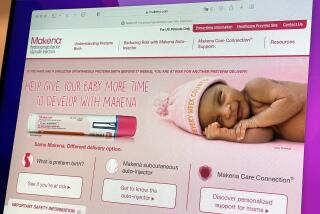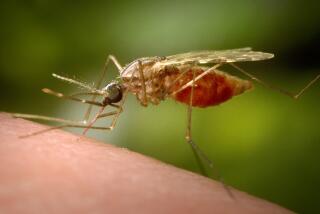Mystery Ebola virus serum manufactured by San Diego firm
- Share via
An experimental serum given to Christian aid workers infected with the deadly Ebola virus was manufactured by a San Diego pharmaceutical firm using plants, the company and U.S. health authorities disclosed Monday.
As Dr. Kent Brantly fights for his life in a special containment unit at Emory University Hospital in Atlanta, and missionary Nancy Writebol prepares to be evacuated from Liberia on Tuesday, details began to emerge about a mysterious treatment they were given shortly after they became infected.
The drug, which was produced by Mapp Biopharmaceutical Inc., is called ZMapp and has not been evaluated for safety in humans, according to a company statement.
“As such, very little of the drug is currently available,” said company President Larry Zeitlin in a statement.
The drug is a cocktail of three “humanized” monoclonal antibodies that are manufactured in a group of fragrant plants or bushes known by the genus name Nicotiana.
Monoclonal antibodies fight viral invaders by locking onto antigens - projections on the surface of a virus that are used to cling to and then enter target cells in the body.
In the case of the Ebola virus, these antigens project like spikes from the virus’ long, spaghetti-like body.
Once these antigens lock onto the surface of a cell, the virus enters and uses the host cell’s machinery to begin mass-producing copies of itself. Antibodies, which can be produced by the immune system or administered as a drug, thwart the ability of antigens to lock onto target cells.
A CNN report that the drug had prompted a “miraculous” recovery and that Brantly’s condition improved within an hour after treatment was greeted with skepticism by longtime Ebola virus researchers.
“I would be ecstatic if Larry’s product helped save these people, but I also need to be extremely cautious,” said Thomas Geisbert, a professor of microbiology and immunology at the University of Texas Medical Branch at Galveston.
“To say the whole thing cleared up in an hour, that doesn’t happen in reality,” Geisbert said. “That’s like something that happens in a movie.”
Ebola virus infection typically begins with flu-like symptoms, such as achy muscles, fever and malaise. As the disease progresses, patients suffer bleeding, rashes, vomiting and diarrhea. If the patients do not receive proper medical care, they can suffer deadly organ failure from the loss of fluids.
Dr. Anthony Fauci, head of the National Institute of Allergy and Infectious Disease, said the company had manufactured only three “courses” of the drug, and that two of them were provided to the American patients.
“This was the first time it was put into humans, because all the previous work was done on animals and the results had been encouraging,” Fauci said.
Fauci said it was hard to say whether or not the medication had been effective. “If you ask Sanjay Gupta, he says the effect was dramatic, but when you have one patient, you have nothing to compare it to. You can’t make a definitive statement,” Fauci said.
Fauci’s agency provided a statement Monday describing how the drug came to be administered to Brantly and Writebol.
The Christian aid organization Samaritan’s Purse had contacted U.S. Centers for Disease Control and Prevention officials in Liberia to discuss the status of experimental treatments they were aware of, the statement said.
Those officials referred the aid group to a National Institutes of Health scientist who was assisting in the Ebola outbreak response in West Africa.
“The scientist was able to informally answer some questions and referred them to appropriate company contacts,” the statement read. “She was not officially representing NIH and NIH did not have an official role in procuring, transporting, approving or administering the experimental products.”
Though some have criticized the decision to transport Brantly and Writebol to the U.S. for treatment, fearing that it would cause the disease to spread here, officials say it is “extraordinarily unlikely.”
Proper hospital procedures will keep the virus isolated, they say, and afford the two patients care that will enable their bodies to fight off the virus.
There is no vaccine or cure for Ebola. The virus has a mortality rate as high as 90%, depending on the strain. It is transmitted through bodily fluids, but not through the air, experts say.
Follow @montemorin for science news







